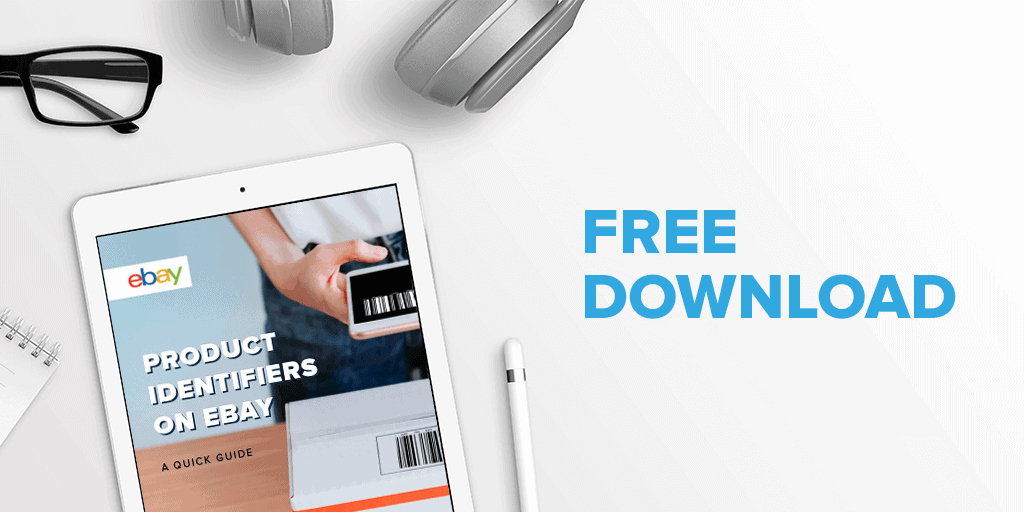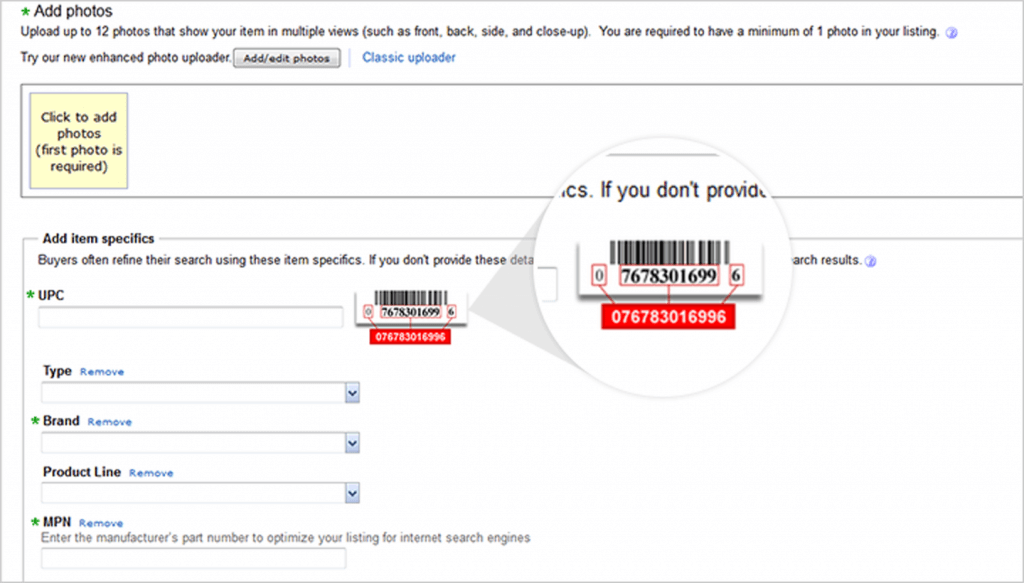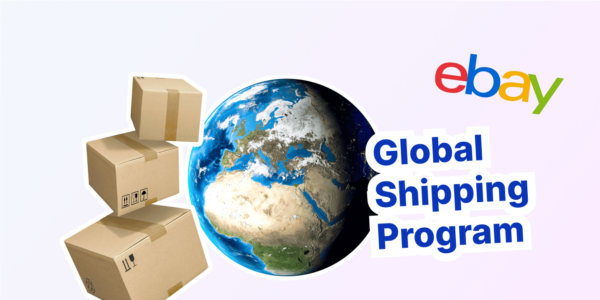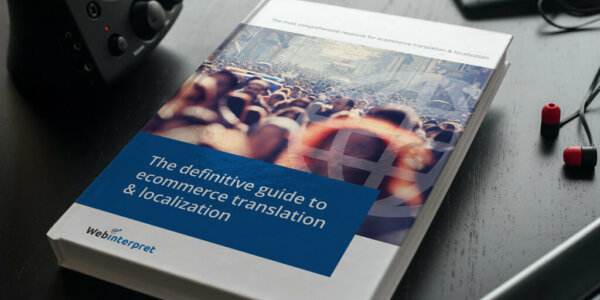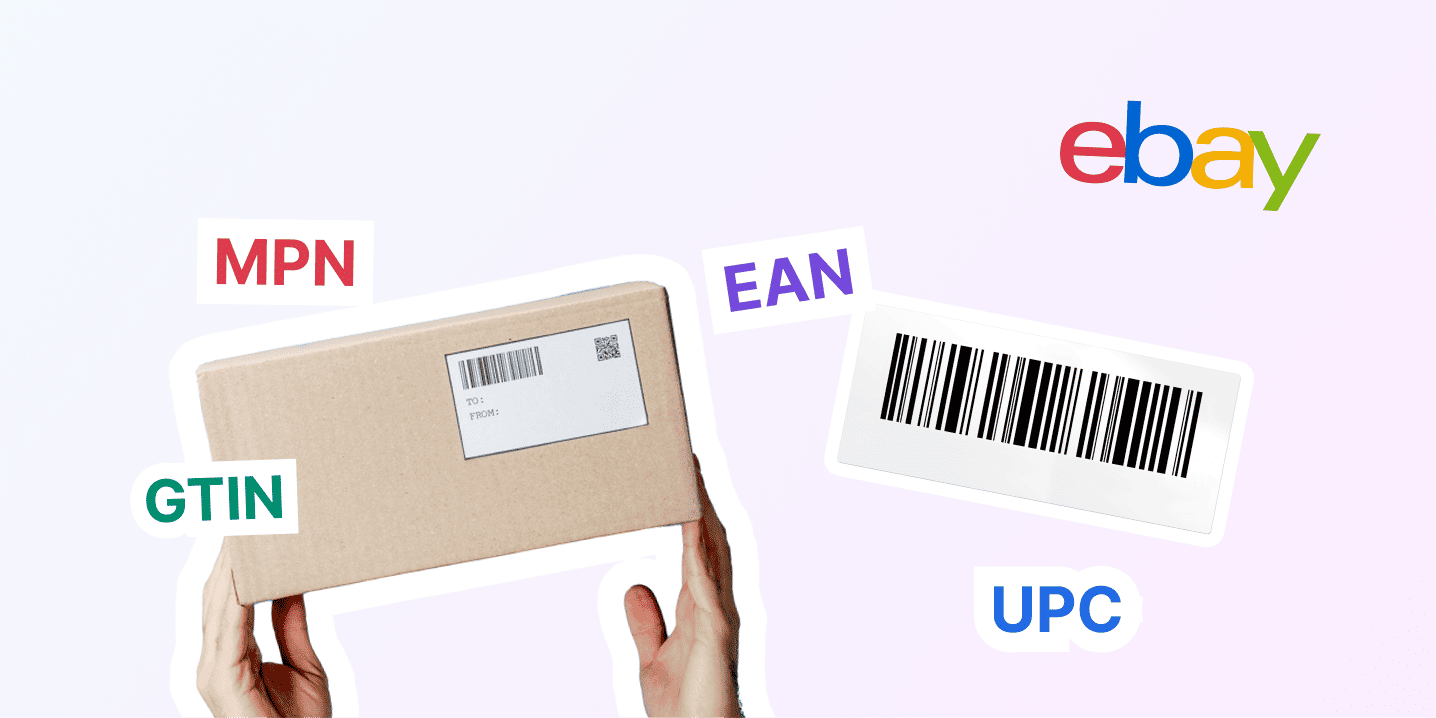
What are Product Identifiers (GTIN, UPC, EAN, MPN) on eBay?
eBay product identifiers (GTIN, UPC, EAN, MPN) should be included for new and refurbished items in certain categories. eBay has been enforcing product identifier requirements since 2016. It’s highly recommended that all eBay sellers add such identifiers to items wherever they apply.
In this article you’ll learn about:
- Product identifiers required on eBay (GTIN, UPC, EAN, MPN), including definitions, examples & benefits
- Adding & finding product identifiers
- Product identifiers & international product listings
- Practical recommendations related to this topic so you sell your products online successfully.
Download our FREE quick guide with the summary of all eBay product identifiers for easier reading and sharing with coworkers.
Click the links below to go directly to the topic of your interest:
GTIN, UPC, EAN: what are product identifiers?
What is UPC?
What is EAN?
What is MPN?
What is ISBN?
Product identifiers on eBay
Product identifiers vs. item specifics on eBay
How to find product identifiers?
Product identifiers and international ecommerce listings
How to add product identifiers to your localized listings on eBay?
GTIN, UPC, EAN: what are product identifiers?
For eBay sellers, and ecommerce sellers in general, there are several codes to pick from. Among the most commonly used are Global Trade Item Numbers (GTINs) assigned by the Uniform Code Council (GS1). Currently, GTIN is used exclusively within bar codes.
GTINs include UPC (in the US), EAN (in Europe), JAN (in Japan), and ISBN. You’ll find their definitions in the later sections of this article.
GTINs are used to look up product information in a database which may belong to a retailer, manufacturer, collector or researcher. The universality and uniqueness of the identifier helps to establish which product in one database corresponds to which product in another database, especially across organizational boundaries.
The family of data structures comprising GTIN include:
- GTIN-12 (UPC-A): 12-digit number used primarily in North America
- GTIN-8 (EAN/UCC-8): 8-digit number used primarily outside of North America
- GTIN-13 (EAN/UCC-13): 13-digit number used primarily outside of North America
- GTIN-14 (EAN/UCC-14 or ITF-14): 14-digit number used to identify trade items at various packaging levels.
Advantages of using product identifiers in commerce
- Product identifiers improve speed, efficiency, and productivity, by eliminating the need to manually enter product information. For instance, the advent of UPC has enabled the use of computerized billing and faster checkouts.
- They help track inventory much more accurately.
- They’re universal: every retailer and every marketplace would use the same code for a certain product.
For more information, watch the video below on why using product identifiers increases chances of being seen.
What is UPC?
UPC stands for Universal Product Code. It’s a barcode, mainly used in the United States, that is printed on retail product packaging. The UPC is primarily used for scanning trade items at the point of sale (per GS1 specifications, based on international standards).
The code is used for tracking trade items in stores and it helps to identify a particular item and its features, e.g. the brand name, item, size or color.
UPC consists of:
- the machine-readable barcode (a series of unique black bars)
- 12 numeric digits (uniquely assigned to each trade item).
What is EAN?
EAN stands for European Article Number and it refers to the standard product identifier used in Europe. It’s compatible with UPC of the USA & Canada and JAN of Japan. EAN is a universal, standardized barcode used throughout the world, now referred to as International Article Number.
EAN vs. UPC
Both EAN and UPC are Global Trade Item Numbers (GTINs). The main difference is that UPCs are one digit shorter than EANs (12 digits vs. 13 digits long). Further, UPCs are more commonly used in the US and Canada.
What is MPN?
MPN stands for Manufacturer Part Number. A part number (PN) is an identifier of a particular part design used in a particular industry with a view to referencing to that part. Normally, the MPN of a product is a series of numbers and letters.
For example, when specifying a screw, it’s easier to refer to “HSC0424PP” (the part number) than saying “Hardware, screw, machine, 4-40, 3/4″ long, pan head, Phillips”.
MPNs are important in a number of industries, e.g. the parts industry for vehicles, machinery, or computer equipment. For example, an oil filter for one car model may not fit another model, even though the same manufacturer makes both car models. The MPN differentiates the oil filter for each type of car.
MPNs are used when uploading products to marketplaces like eBay as well as comparison shopping engines. They allow search engines to match products with search queries and make product comparisons more accurate.
They also ensure accurate details in product listings on eBay and other platforms. In general, they help customers buy the right item.
MPN vs. GTIN vs. SKU
Just like GTINs, MPNs help to identify individual products in the database. However, some comparison shopping engines, like Google Shopping, prefer GTINs to MPNs in product data feeds. Thus, MPNs are sometimes optional if the GTIN is there.
Unlike GTINs, MPNs are assigned by manufacturers.
Further, MPNs differ from SKUs (Stock Keeping Units). Some vendors use SKUs for product categorization and identification systems for internal purposes. Thus, a vendor may assign its own internal SKU number to a product from a manufacturer that also has an MPN.
Comparison shopping engines and product marketplaces don’t use SKUs and customers rarely use them. You can use SKU numbers for internal purposes, but when creating a product feed for online marketing and advertising, you need the MPN for each product.
What is ISBN?
ISBN stands for International Standard Book Number. An ISBN is currently a 13-digit product identifier used by publishers, booksellers, libraries or internet retailers.
In terms of the type of media available, it doesn’t matter in what form the content is documented and distributed. However, you should identify each different product form (e.g. paperback, EPUB, .pdf) separately.
Product identifiers on eBay
eBay uses item brands, Manufacturer Part Numbers (MPN), and Global Trade Item Numbers (GTINs), such as Universal Product Codes (UPCs) and International Standard Book Numbers (ISBNs), to help buyers quickly find the items they’re looking for in specific categories.
The benefits of product identifiers on eBay are as follows:
- Help buyers find the right items
- Help improve placement/visibility in search engines like Google and Bing
- Make your items eligible for inclusion in more deals and promotions
- Prepare your items for future enhancements, such as new product reviews
- Make pricing more accurate when listing items
- Make listing information and item specifics more robust by automatically matching your items with products in eBay’s catalog
- Alert you when your listings are priced lower than the trending price.
For more information about product identifier requirements, check out eBay’s helpful guide to utilizing product identifiers.
[Want to increase your international sales? Watch our video about the benefits of eBay’s Global Shipping Programme]
Product identifiers vs. item specifics on eBay
Similarly to product identifiers, adding item specifics to product listings helps to increase their visibility.
Many item specifics are critical to the buyer search experience and will ensure that you get maximum visibility. This is extra important for mobile search so shoppers can refine search results on smaller screens.
Item specifics are currently required on eBay in a number of categories, e.g. Fashion (also the booming luxury fashion category), Vehicle Parts & Accessories categories Home & Garden or Toys & Games.
Check out the item specifics requirements for different categories.
To check the benefits of adding item specifics to your eBay listings, watch the video below.
How to find product identifiers?
Most manufacturers list identifiers like MPN and GTIN directly on a product or packaging. Remember, when you match your item with a product in the eBay catalog, the unique identifiers for your item are included automatically in your listing. Below are a few examples of product identifiers.
UPC Code:
ISBN:
MPN code:
If you’re interested in what’s new on eBay, check out the section with eBay updates.
Product identifiers and international ecommerce listings
Webinterpret clients benefit from a free, automated service that modifies internationally localized items as follows:
- If the original item includes an identifier – Webinterpret will add the original item’s Required Product Identifier (GTIN, EAN, UPC, MPN or ISBN) to the localized international item.
- If the original item doesn’t include an identifier – Webinterpret will set “Does not apply” in the appropriate field when creating the localized item.
Once you have updated your original listings, the changes will be applied automatically to your Webinterpret localized listings.
How to add product identifiers to your localized listings on eBay?
Ecommerce merchants selling with Webinterpret are obliged to add product identifiers to the original items, not the ones translated by Webinterpret. Your modification will be applied to the localized listings within a few hours. You must add the product identifier in the appropriate field as shown below:
You can add product identifiers to your existing listings using the drop-down menus found in eBay’s bulk listing and editing tool.
Be careful with the “Does Not Apply” option and missing item specifics!
On marketplaces product identifiers are mandatory in a number of categories. However, some sellers apply the “Does Not Apply” option to the majority of their listings. This may hurt those sellers in the long run.
The reality is that items with “Does not apply” may eventually lose sales after falling in search engine rankings.
For this reason, we urge merchants to update all original items with missing product identifiers. (The option “Does Not Apply” won’t be available anyway when creating new listings in categories where a product identifier is compulsory).
Further, it’s highly recommended that you provide as many item specifics as you can. eBay makes you add catalog information so they can compare products better in search results. If it’s blank, eBay is more likely to exclude it from search results.
Besides eBay, certain item specifics, along with product identifiers, can help your listings appear in Google Shopping results. Google uses product identifiers to identify products and thus position them in their own products catalog.
Google finds these values very important for matching users’ queries to your products.
Google also insists on at least a GTIN for products to be included in their product feeds. As a result, without the required information, eBay can’t upload your products to Google.
How to update multi-variation items?
Please bear the following in mind:
- Brand needs to be added at item level (not in the variation)
- EAN/UPC and MPN numbers need to be added at variation level
- If you don’t have the values you can also add “unbranded” for Brand and “Does not apply” for EAN & MPN
About Webinterpret: translate & localize your marketplace listings
Webinterpret enables eBay and other marketplace sellers to instantly expand worldwide. Our automatic ecommerce solution will help you with translating and localizing your product listings so you can quickly & easily boost your online sales. Contact our ecommerce experts for more information.

Advertising on eBay? Download our eBay Promoted Listings guide!
Related Posts:
Ecommerce Newsletter
By clicking the “Subscribe now” button, you agree to receive our monthly e-mail newsletter and regular marketing and commercial communications by email from Webinterpret regarding marketing trends and our digital marketing services. You confirm that you have read and agreed to Webinterpret’s Terms of Service and Privacy Policy.
